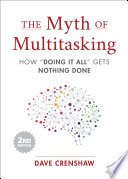

The central premise of the book is that multitasking, often glorified in modern workplaces, is fundamentally a myth. The author argues that what we perceive as multitasking is actually task-switching, which can lead to decreased productivity and increased errors. This idea is supported by research that shows the brain struggles to focus on multiple tasks simultaneously. Instead of effectively managing several tasks at once, individuals are merely shifting their attention back and forth, which consumes cognitive resources and can result in mental fatigue. The author emphasizes that understanding this distinction is crucial for improving personal productivity and effectiveness.
Continue readingThe book delves into Cognitive Load Theory, which posits that our brains have limited processing capacity. When we overload our cognitive resources by attempting to juggle multiple tasks, we hinder our ability to perform any one task well. The author explains that this overload can lead to stress, burnout, and reduced performance. By recognizing our cognitive limits, individuals can learn to prioritize tasks and focus on one thing at a time, ultimately leading to better outcomes and a more manageable workload.
Continue readingTask switching incurs a significant cost, both in terms of time and mental energy. The author presents research showing that switching from one task to another can take up to 25% of our productive time. This time loss is often invisible, as we may not realize how much time is wasted in the transition between tasks. The book encourages readers to adopt strategies that minimize task switching, such as batching similar tasks together and setting dedicated time blocks for focused work. By doing so, individuals can reclaim lost time and enhance their productivity.
Continue readingFocus is presented as a critical component of effective work. The author argues that deep work—concentrating on a single task without distraction—is essential for producing high-quality results. The book advocates for creating an environment conducive to focus, which includes reducing distractions from technology and setting boundaries around work time. Techniques such as the Pomodoro Technique, which involves working in short, focused bursts followed by breaks, are suggested to help maintain concentration and improve overall productivity.
Continue readingMindfulness practices are highlighted as beneficial for combating the negative effects of multitasking. The author discusses how being present in the moment can enhance focus and reduce the stress associated with juggling multiple responsibilities. Mindfulness techniques, such as meditation and conscious breathing, can help individuals develop better awareness of their thoughts and emotions, leading to improved decision-making and a greater sense of control over their workload.
Continue readingThe book calls for a reevaluation of workplace cultures that promote multitasking as a desirable trait. The author critiques environments where employees are expected to handle numerous tasks simultaneously, arguing that this leads to inefficiencies and diminished job satisfaction. By fostering a culture that values deep work and focused effort, organizations can enhance employee well-being and productivity. The book encourages leaders to model and promote practices that prioritize focus and minimize distractions.
Continue readingThe author provides practical strategies for individuals and organizations to reduce multitasking. These include setting clear priorities, creating structured schedules, utilizing technology mindfully, and establishing 'no interruption' zones. The book also emphasizes the importance of taking regular breaks to recharge and maintain mental clarity. By implementing these strategies, readers can cultivate a more productive and fulfilling work environment that aligns with their cognitive capabilities.
Continue reading